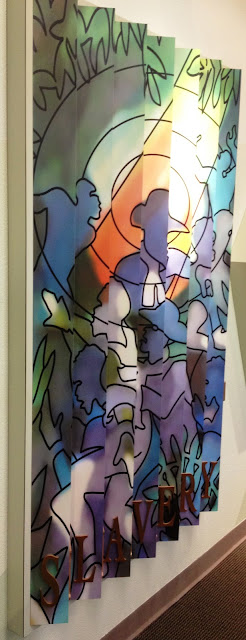FAM 2013: Favorite Site Spotlight--Fort Mose Historic State Park
I made a quick trip over to Fort Mose today to deliver a batch of Florida Archaeology Month posters. Fort Mose is one of the sites depicted on this year's poster, which highlights the vast diversity illuminated by Florida archaeology.
While I was there, I took a stroll through the visitor center's interpretive space. In 2011, interpretation at Fort Mose was updated; it now features interactive, multi-sensory stations, along with gorgeous artistic depictions of life in Spanish Florida. It was so spectacular, in fact, I couldn't keep it to myself.
Below: a single 3D canvas presents a gorgeous rendering of the contrast between slavery and freedom.

As visitors approach the building, they can stop to read a series of panels that detail the origins and history of Fort Mose.
Once inside, we are enveloped in beautiful artistry and storytelling; state-of-the-art listening stations allow us to hear first-person accounts of escaping slavery and life at Mose.

 Artifact displays throughout the room shed light on the material culture uncovered at the site.
Artifact displays throughout the room shed light on the material culture uncovered at the site.
Continuing through the space, we trace a timeline of northeast Florida's colonial past, and then this:
The holy grail of interpretation for archaeologists: video featuring archaeology legend, Dr. Kathleen Deagan, as she recounts excavating the site.
Adjacent interpretation focuses on what historical documents revealed about Fort Mose, helping to complete a picture for visitors regarding how we learned what we now understand about life at the first settlement of freed black people in (what is now) the U.S.
A final stop compares what archaeologists saw in profile at Fort Mose as compared with the Castillo de San Marcos and Hontoon Island (see the close-up of Fort Mose's moat in profile, below right).

These are only snippets and snapshots of the rich and fascinating interpretation at Fort Mose. If you haven't been yet, go! If you haven't been since the new displays were installed...go! It's entertaining, enriching, and well worth the park fee ($2 per person/children 5 & under free).
Fort Mose is open Thursday through Monday, 9am-5pm. To learn more about the park, visit its website. You can also follow them on Twitter!
What's your favorite site to visit? Is there a site you'd like people to see, whose interpretation tells a crucial, but maybe little-known piece of Florida's story? We want to hear about them!
Text by Amber Weiss
Photos courtesy of the Florida Public Archaeology Network
While I was there, I took a stroll through the visitor center's interpretive space. In 2011, interpretation at Fort Mose was updated; it now features interactive, multi-sensory stations, along with gorgeous artistic depictions of life in Spanish Florida. It was so spectacular, in fact, I couldn't keep it to myself.
Below: a single 3D canvas presents a gorgeous rendering of the contrast between slavery and freedom.

As visitors approach the building, they can stop to read a series of panels that detail the origins and history of Fort Mose.
 |
| Panels leading to the visitors center interpret the history of the people living at Fort Mose and the history of the site itself. |
 |
| Each panel tells a piece of the story; many include low-relief, touchable artifact replicas. |
Once inside, we are enveloped in beautiful artistry and storytelling; state-of-the-art listening stations allow us to hear first-person accounts of escaping slavery and life at Mose.

 Artifact displays throughout the room shed light on the material culture uncovered at the site.
Artifact displays throughout the room shed light on the material culture uncovered at the site. Continuing through the space, we trace a timeline of northeast Florida's colonial past, and then this:
The holy grail of interpretation for archaeologists: video featuring archaeology legend, Dr. Kathleen Deagan, as she recounts excavating the site.
 |
| The video (complete with captions) shows excavation at Fort Mose as it was taking place, and Dr. Deagan discusses the precision necessary to excavate Fort Mose. The video is captioned. |
Adjacent interpretation focuses on what historical documents revealed about Fort Mose, helping to complete a picture for visitors regarding how we learned what we now understand about life at the first settlement of freed black people in (what is now) the U.S.
A final stop compares what archaeologists saw in profile at Fort Mose as compared with the Castillo de San Marcos and Hontoon Island (see the close-up of Fort Mose's moat in profile, below right).

These are only snippets and snapshots of the rich and fascinating interpretation at Fort Mose. If you haven't been yet, go! If you haven't been since the new displays were installed...go! It's entertaining, enriching, and well worth the park fee ($2 per person/children 5 & under free).
Fort Mose is open Thursday through Monday, 9am-5pm. To learn more about the park, visit its website. You can also follow them on Twitter!
What's your favorite site to visit? Is there a site you'd like people to see, whose interpretation tells a crucial, but maybe little-known piece of Florida's story? We want to hear about them!
Text by Amber Weiss
Photos courtesy of the Florida Public Archaeology Network



